Order of Diplomatic Service Merit 수교훈장 (樹交勳章)
The Order of Diplomatic Service Merit is awarded to those who have rendered meritorious service to the extension of national prestige overseas and to the promotion of friendship with other nations.
On May 16, 1961, Major General Park Chung-hee seized power in a military coup. One of his first major problems was to legitimize his government in the eyes of other democratic nations, primarily the U.S. He not only needed foreign help to maintain the nation’s security, but he also needed large sums of money for his 5-year economic development plans. Korea went on a diplomatic binge. Before the coup, Korea had 13 embassies and 5 consulates, and shortly after the coup, there were 38 embassies and 9 consulates. Part of this diplomatic binge, was the creation of the Order of Diplomatic Service Merit, on July 25, 1961.1 It is awarded to those who distinguish themselves toward the extension of national power or promotion of friendship with friendly nations.
The Order of Diplomatic Service Merit is the only Korean Order, where the qualifications for receiving the Order are based on merit, but the wearing of the Order is restricted upon the Korean recipient’s rank or status in a given situation. An example of the courtesy rule would be a Korean Ambassador to a small nation who is later reassigned to a much more important nation, but at a slightly lower position. At a given diplomatic function, even though he had been awarded the 1st Class at his last posting, at his new position he would wear the 2nd class when in the presence of the Ambassador. These standards also apply to ambassadors extra-ordinaries and plenipotentiaries, special envoys, government representatives, or other members of the suite. The criteria for wearing an award are based on the following courtesy rules: the 1st Class for Ambassador Level or higher, the 2nd Class for Ministerial Level, the 3rd Class for Councilor level, the 4th Class for Second Secretary, and the 5th Class for the Third Secretary level.2
Today, awards presented to foreigners are covered under the “Recommendation Regulations for Decorations to Foreigners” (외국인서훈추천규정).3 Article 5, Section 1, of the revised regulations, specifically deals with the Order of Diplomatic Service Merit.4 Foreign ambassadors with 2 years or more in Korea, receive the 1st Class Order of Diplomatic Service Merit, while those with less than 2 years receive the 2nd Class. Foreign envoys also receive the 2nd Class. Consulate Generals with more than 2 years in Korea receive the 2nd Class, while those with less than 2 years receive the 3rd Class award. Embassy Councilors are also entitled to the 3rd Class. 1st and 2nd Class Secretary/Consuls receive the 4th Class Order of Diplomatic Service Merit, while a 3rd class Secretary or Vice-consul receives the 5th Class.
This Order has not been without controversy. In June 1970, Nobusuke Kishi, who was considered a World War II Class A War Criminal, was invited to the Blue House and awarded the Order of Diplomatic Merit, Gwanghwa Medal, for his contribution to re-establishing, post-colonial, diplomatic relations between Korea and Japan.5
Because this order is awarded to so many foreigners, and because the majority of the recipients are high-ranking diplomats, the rarity guide is reversed. As of Dec. 31, 1983, there were 771 First Class, 350 Second Class. 203 Third Class, 88 Fourth Class and 61 Fifth Class Orders of Diplomatic Service Merit that were awarded. In addition, there were only 5 Diplomatic Service Merit Medals issued.6 Please keep this in mind when considering an Order of Diplomatic Service. The higher classes are actually more common than the lower classes.
1961 SERIES
On July 25, 1961, under Cabinet Decree #68, the Order of Diplomatic Service Merit was established in six classes, with no specific name for each class. The original concept drawings and the original legislation, both show the Chinese 囍 (행복하다) ideogram incorporated into the suspension on the first, second and third classes. According to the South Korean Medal Roll, the first Orders of Diplomatic Service were issued during the following Series and not during this, the 1961 Series. To date, no examples of this type of suspension have been observed. The Chinese ideogram 喜 (행복) is usually translated as “Joy” or “Happiness”. When the character is doubled 囍, it is generally translated as “double joy” or “double happiness”. There are no lapel pins for this series. There are no attachments to any of the ribbons or ribbon bars.
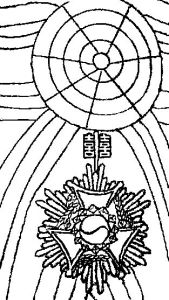
Order of Diplomatic Service Merit, First Class
Notice the 囍 character in the suspension – Drawing courtesy of the Korean Office of Protocol, Orders, and Medals Dept.
Symbols employed: The sun shape of the Order symbolizes enhancement of national prestige; the three large white rays, the three thousand “RI” 리 (里).7 of territory and thirty million people; the white color, the Korean people; the laurel, freedom, peace, and victory; the Mugunghwa and its bows, national prosperity and diplomacy with foreign countries for peace and equality; the diamond, noble steadfastness and immobility; the twisted belt around the Taeguk, strong capacity for unity and friendly relations with foreign countries; the Taeguk, the ROK. The green color of the ribbon symbolizes peace and equality; the white color, integrity and innocent character; the red color, bravery and progressive passion.
Note: The colors and widths for the various ribbons and ribbon bars were taken from the document that are recorded in the Official Gazette (관보 Kwanbo). The translations from Chinese into Korean characters, that are available on the internet, were not accurate and showed several ribbons whose color pattern and widths did not match the ribbon bars.
- 1st Class The pendant has a 62 mm diameter and is suspended from an 85 × 1,900 mm sash. The ribbon colors for the sash are: green 록색 (綠色) 15 mm, red 홍색 (紅色) 10 mm, white 백색 (白色) 5 mm, red 홍색 4.25 mm, white 백색 10 mm, red 홍색 4.25 mm, white 백색 5 mm, red 홍색 10 mm, and green 록색 15 mm. The breast star has a diameter of 90 mm. The ribbon bar is 36 × 9 mm and the colors are: green 록색 (綠色) 5 mm, red 홍색 5.5 mm, white 백색 (白色) 2 mm, red 홍색 3 mm, white 백색 5 mm, red 홍색 3 mm, white 백색 2 mm, red 홍색 5.5 mm, and green 록색 5 mm.
- 2nd Class The pendant has a 70 mm diameter and is suspended from a 36 × 400 mm cravat. The ribbon colors are: red 홍색 5 mm, green 록색 5.5 mm. white 백색 2 mm, green 록색 3 mm, white 백색 5 mm, green 록색 3 mm, white 백색 2 mm, green 록색5.5 mm, and red 홍색 5 mm. The breast star is 70 mm. The ribbon bar is 36 × 9 mm and the colors and widths match those of the cravat.
- 3rd Class The pendant has a 62 mm diameter and is suspended from a 36 × 400 mm cravat. The ribbon colors are: green 녹색 5 mm, red 홍색 7 mm, white 백색 4 mm, red 홍색 4 mm, white 백색 4 mm, red 홍색 7 mm, and green 록색 5 mm. There is no breast star. The ribbon bar is 36 × 9 mm and the colors and widths match the cravat.
- 4th Class The pendant has a 62 mm diameter and is suspended from a 36 × 100 mm breast ribbon. The ribbon colors are: red 홍색 5 mm, green 녹색 7 mm, white 백색 4 mm, green 녹색 4 mm, white 백색 4 mm, green 녹색 7 mm, and red 홍색 5 mm. The ribbon bar is 36 × 9 mm and the colors and widths match the breast ribbon.
- 5th Class The pendant has an 80 mm diameter and is suspended from a 36 × 100 mm breast ribbon. The ribbon colors are: green 록색 5 mm, red 홍색 11 mm, white 백색 4 mm, red 홍색 11 mm, and green 록색 5 mm. The ribbon bar is 36 × 9 mm and the colors and widths match the breast ribbon.
- 6th Class The pendant has a 50 mm diameter and is suspended from a 36 × 100 mm breast ribbon. The ribbon colors are: red 홍색 5 mm, green 록색 11 mm, white 백색 4 mm, green 록색 11 mm, and red 홍색 5 mm. The ribbon bar is 36 × 9 mm and the colors and widths match the breast ribbon.
1962 SERIES
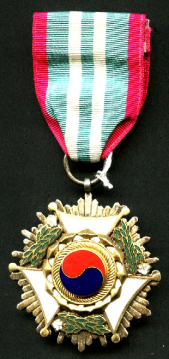
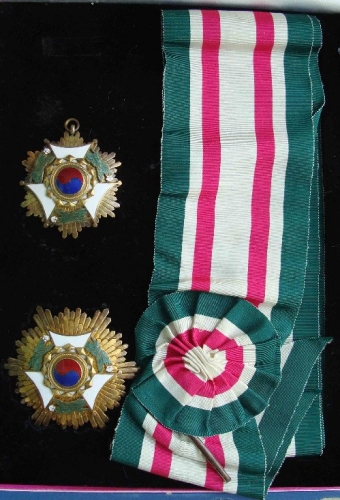
On Jan. 29, 1962, Cabinet Decree #420 was issued. If the July 1961 series did have the Chinese 囍 ideogram in the suspension, it was dropped six months later when the 1962 series was issued. There are no lapel pins for this series. There are no attachments or rosettes to any of the ribbons or ribbon bars.
- 1st Class The pendant has a 60 mm diameter and is suspended from an 85 × 1,900 mm sash. The ribbon colors for the sash are: Green 15 mm, white 7 mm, red 10 mm, white 21 mm, red 10 mm, white 7 mm, and green 15 mm. The breast star has a diameter of 75 mm. The ribbon bar is 36 × 11 mm and the colors are: Green 7 mm, white 3 mm, red 4 mm, white 8 mm, red 4 mm, white 3 mm, and green 7 mm.
- 2nd Class The pendant has a 55 mm diameter and is suspended from a 36 × 650 mm cravat. The ribbon colors are: red 5 mm, green 5.5 mm, white 2 mm, green 3 mm, white 5 mm, green 3 mm, white 2 mm, green 5.5 mm, and red 5 mm. The breast star is 70 mm. The ribbon bar is 36 × 11 mm and the colors and widths match those of the cravat.
- 3rd Class The pendant has a 55 mm diameter and is suspended from a 36 × 650 mm cravat. The ribbon colors are: Green 5 mm, red 7 mm, white 4 mm, red 4 mm, white 4 mm, red 7 mm, and green 5 mm. There is no breast star. The ribbon bar is 36 × 11 mm and the colors and widths match the cravat.
- 4th Class The pendant has a 50 mm diameter and is suspended from a 36 × 46 mm breast ribbon. The ribbon colors are: Red 5 mm, green 7 mm, white 4 mm, green 4 mm, white 4 mm, green 7 mm, and red 5 mm.
- The ribbon bar is 36 × 11 mm and the colors and widths match the breast ribbon.
- 5th Class The pendant has a 45 mm diameter and is suspended from a 36 × 46 mm breast ribbon. The ribbon colors are: Red 5 mm, green 11 mm, white 4 mm, green 11 mm, red 5 mm, and green 11 mm. The ribbon bar is 36 × 11 mm and the colors and widths match the breast ribbon.
- 6th Class The pendant has a 40 mm diameter and is suspended from a 36 × 46 mm breast ribbon. The ribbon colors are: Green 5 mm, red 11 mm, white 4 mm, red 11 mm, and green 5 mm. The ribbon bar is 36 × 11 mm and the colors and widths match the breast ribbon.
1963 SERIES
On Dec. 14, 1963, Decorations Law #1519 was issued. There were very few changes to the physical dimensions of the Order. The 3rd Class pendant now has a diameter of 52 mm instead of 55 mm, and the 3rd Class cravat is now 36 × 450 instead of 36 × 650.8 There are some other, very minor changes to the dimensions on some pendants and breast stars. The most significant change was the 6th Class, which was dropped from the Order. According to the Korean Medal Roll, no 6th Class of the Order of Diplomatic Service was ever issued. However, the published Korean Medal Roll equates all awards in the award terms currently used. For example, the Defense Merit Medal issued in the 1950s and 1960s is listed on the rolls as the Military Merit Medal. It is quite possible that the Korean government simply rolled all the 6th Class awards into the 5th Class numbers. To date, I have not found a Diplomatic Order of Service Merit which has a reverse stating 6th Class (六등).
1967 SERIES
Under Presidential Decree #2929, the obverse design and ribbon colors are changed to the style currently in use.

Notice the 4 cabochons around the center.
Symbols employed: The laurel crown on the suspension device means peace and freedom, while the goose feathers, which are also on the suspension, indicate a linkage with foreign countries. The red wings of the cross indicate the four directions as well as the brilliance of the work. The sun’s rays symbolize the heightened dignity of the country. The smaller white wings indicate holiness. The purple pearls indicate the fruitage of the hard work. The intricate design around the pearls, the Dangchomoon, indicates the wood supporting the girder, symbolizing the supporting of the country. And the Taeguk at the center symbolizes the Republic of Korea. The rose pink / light red (scarlet) color found on the ribbons symbolizes mental combative spirit, while the brown color indicates majesty.
- 1st Class The pendant has a 60 mm diameter and is suspended from an 80 × 1,700 mm sash. The sash is a solid pink color 담홍색 (淡紅色). The breast star has a diameter of 70 mm. The ribbon bar is 36 × 10 mm and is also pink with no stripes. There is a 1.7 cm lapel pin.
- 1st Class (sized) for Ladies The pendant has a 45 mm diameter and is suspended from a 70 × 1,700 mm sash. The sash is a solid pink color 담홍색 (淡紅色). The breast star has a diameter of 50 mm. The ribbon bar and lapel pin are identical to the men’s size.
- 2nd Class The pendant has a 55 mm diameter and is suspended from an 80 × 1,700 mm sash. The sash has two 7 mm brown/dark brown 진갈색 (眞褐色) stripes, one each side of the pink center stripe. The breast star is 60 mm in diameter. The ribbon bar is 36 × 10 mm and has two 1.7 mm brown stripes, one on each side of a 22 mm pink center stripe. There is a 1.7 cm lapel pin.
- 2nd Class (sized) for Ladies The legislation, as recorded in the Official Gazette (Kwanbo), does have a drawing of a 2nd Class (sized) for ladies, but does not give any dimensions, colors, etc. There is a small note at the bottom of the drawing, which states that it is the same as the 2nd Class in the men’s size 略章및 襟章의 制式은 男子用과 같다. The translations of the original Chinese legislation into Korean, do not show anything regarding a 2nd Class for Ladies.
- 3rd Class The pendant has a 50 mm diameter and is suspended from a 36 mm x 600 mm cravat. The cravat has two 5 mm brown/dark brown stripes, one each side of the 20 mm pink center stripe. There is no breast star. The ribbon bar is 36 × 10 mm and the colors and widths match the cravat. There is a 1.7 cm lapel pin.
- 4th Class The pendant has a 45 mm diameter and is suspended from a 38 × 110 mm breast ribbon. The ribbon has four, 2 mm brown/dark brown stripes, with two on each side of a 20 mm pink center stripe. There is a rosette on the ribbon. The ribbon bar is 36 × 10 mm and the colors and widths match the breast ribbon. There is a 1.7 cm lapel pin.
- 5th Class The pendant has a 40 mm diameter and is suspended from a 36 × 110 mm breast ribbon. The ribbon has two 2 mm brown/dark brown stripes, with one on each side of a 24 mm pink center stripe. There is no attached rosette on the ribbon. The ribbon bar is 36 × 10 mm and the colors and widths match the breast ribbon. There is a 1.7 cm lapel pin.
1969 SERIES
Under Presidential Decree #4466, there is only one difference between the 1967 Series and the 1969 Series. The lapel pins which had been round with a 17 mm diameter are now 12 × 8 mm rectangles. The drawings in the original legislation clearly show the pattern of stripes on the various lapel pins, but no dimensions are given. The stripes on the lapel pin mimic the ribbons and ribbon bars.
The dimensions, ribbon colors, etc. are the same as the 1967 legislation except for two items. The ribbon bars are now 38 × 10. The other change was to the 2nd Class that is (sized) for Ladies. The 1969 legislation gives the following information:
- 2nd Class (sized) for Ladies The pendant has a 43 mm diameter and is suspended from a 70 × 1,700 mm sash. The sash is a solid pink color 담홍색 (淡紅色). There is no mention of stripes in the legislation. The breast star has a diameter of 45 mm. The ribbon bar and lapel pin are identical to the men’s size.
1970 SERIES
On Nov. 17, 1970, under Presidential Decree #5388, all the classes for the Order of Diplomatic Service merit were renamed. There are no physical size or weight changes from the earlier series. The only way to tell the difference is to look at the wording on the reverse of the pendants and/or the breast stars. The new names are:
- Gwanghwa Medal 광화장 (光化章)
- Heung-in Medal 홍인장 (興仁章)
- Sungrye Medal 숭례장 (崇禮章)
- Chang-eui Medal 창의장 (彰義章)
- Sugjeong Medal 숙정장 (肅靖章)
1971 SERIES
Presidential Decree #5688 was issued on June 30, 1971. Much of the legislation is identical to the 1967 series. There were several changes to the ribbons and stripes. The base color for the ribbons is still described as rose pink, but the smaller stripes are now described as orange 등색 (燈色). All five classes have a 38 × 10 mm ribbon bar and a 12 × 8 mm lapel pin.
- Gwanghwa Medal 광화장 (光化章) The pendant has a 60 mm diameter and is suspended from an 80 × 1,700 mm sash. The sash is a solid pink color 담홍색 (淡紅色). The breast star has a diameter of 70 mm. The ribbon bar is 38 × 10 mm and has two 6 mm Orange 등색 (燈色) stripes, one on each side of a 24 mm pink stripe. There is a 12 × 8 mm lapel pin.
- Gwanghwa Medal 광화장 (光化章) (sized) for Ladies The pendant has a 45 mm diameter and is suspended from a 65 × 1,700 mm sash. The sash is a solid pink color 담홍색 (淡紅色). The breast star has a diameter of 50 mm. The ribbon bar and lapel pin are identical to the men’s size. Same as the 1967 and 1969 legislation.
- Heung-in Medal 홍인장 (興仁章) The pendant has a 55 mm diameter and is suspended from an 80 × 1,700 mm sash. The sash has two 9 mm orange stripes, one each side of the 60 mm, pink center stripe. The breast star is 60 mm in diameter. The ribbon bar is 38 × 10 mm and has eight 2 mm orange stripes, four on each side of a 12 mm pink center stripe. There is a 12 × 8 mm lapel pin.
- Heung-in Medal 홍인장 (興仁章) (sized) for Ladies The pendant has a 43 mm diameter and is suspended from a 65 × 1,700 mm sash. The sash has two 9 mm orange stripes, one on each side of a 45 mm pink center stripe. The breast star has a diameter of 50 mm. The ribbon bar and lapel pin are identical to the men’s size. Same as the 1967 and 1969 legislation.
- Sungrye Medal 숭례장 (崇禮章) The pendant has a 50 mm diameter and is suspended from a 38 × 600 mm cravat. The cravat has six 1.5 mm orange stripes, three on each side of the 19 mm pink center stripe. There is no breast star. The ribbon bar is 38 × 10 mm and the colors and widths match the cravat. There is a 12 × 8 mm lapel pin.
- Chang-eui Medal 창의장 (彰義章) The pendant has a 45 mm diameter and is suspended from a 38 × 100 mm breast ribbon. The ribbon has four, 2 mm orange stripes, with two on each side of a 20 mm pink center stripe. There is a rosette on the ribbon. The ribbon bar is 38 × 10 mm and the colors and widths match the breast ribbon. There is a 12 × 8 mm lapel pin.
- Sugjeong Medal 숙정장 (肅靖章) The pendant has a 40 mm diameter and is suspended from a 38 × 100 mm breast ribbon. The ribbon has two 2.5 mm orange stripes, with one on each side of a 29 mm pink center stripe. There is no attached rosette on the ribbon. The ribbon bar is 38 × 10 mm and the colors and widths match the breast ribbon. There is a 12 × 8 mm lapel pin.
1973 SERIES
On Nov. 11, 1973, under Presidential Decree #6916, the Korean government introduced changes to the 4th and 5th classes.
- Chang-eui Medal 창의장 (彰義章) The pendant has a 50 mm diameter and is suspended from a 38 × 100 mm breast ribbon. The ribbon has four, 1.5 mm orange 등색 (燈色) stripes, with two on each side of a 24 mm pink center stripe. There is a rosette on the ribbon drape. The ribbon bar is 38 × 10 mm and the colors and widths match the breast ribbon. There is a 12 × 8 mm lapel pin.
- Sugjeong Medal 숙정장 (肅靖章) The pendant has a 50 mm diameter and is suspended from a 38 × 100 mm breast ribbon. The ribbon has two 2 mm orange 등색 (燈色) stripes, with one on each side of a 30 mm pink center stripe. There is a rosette on the ribbon drape. The ribbon bar is 38 × 10 mm and the colors and widths match the breast ribbon. There is a 12 × 8 mm lapel pin.
1974 SERIES
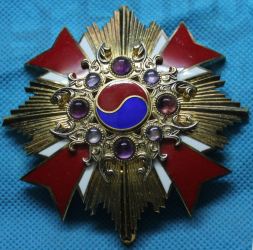
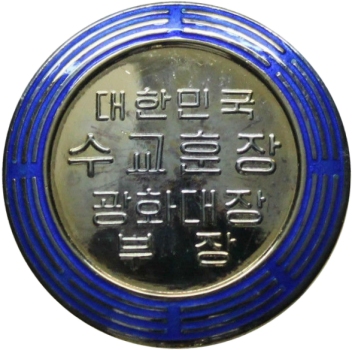
대한민국 Republic of Korea
Order of 수교훈장 Diplomatic Service Medal
과 화대장 Grand Gwangwha Medal
부장 Breast Star
On Oct. 23, 1974, under Presidential Decree #7289, the first Class of the Order, the Gwanghwa Class, was split in two grades. The new grade of the first Class was named the Grand Gwanghwa. This new, 1st Grade of the 1st Class, can be readily identified by the 8 purple cabochons around the centers of the pendant and breast star. There are no changes to the remaining classes.
- Grand Gwanghwa Medal 광화대장 (光化大章) The pendant has a 65 mm diameter and is suspended from an 80 × 1,700 mm sash. The sash is a solid pink color 담홍색 (淡紅色). The breast star has a diameter of 75 mm. The ribbon bar is 38 × 10 mm and a 12 × 8 mm lapel pin. There are no stripes on the sash, ribbon bar or lapel pin.
- Grand Gwanghwa Medal 광화대장 (光化大章) (sized) for Ladies The pendant has a 50 mm diameter and is suspended from a 65 × 1,700 mm sash. The sash is a solid pink color 담홍색 (淡紅色). The breast star has a diameter of 55 mm. The ribbon bar is 38 × 10 mm and a 12 × 8 mm lapel pin. There are no stripes on the sash, ribbon bar or lapel pin.
1984 SERIES
On Jan. 23, 1984, under Presidential Decree #11336, the government made several changes to the Order of Diplomatic Service Merit. All classes have a 38 × 10 mm ribbon bar and a 12 × 8 mm lapel pin. The base color of the ribbons is still pink 담홍색 (淡紅色). The legislation now states that the stripes are dark brown 진갈색 (眞褐色). This is the current series used today.
- Grand Gwanghwa Medal 광화대장 (光化大章) The pendant has a 75 mm diameter and is suspended from an 80 × 1,800 mm sash. The sash is a solid pink color 담홍색 (淡紅色). The breast star has a diameter of 80 mm. The ribbon bar is 38 × 10 mm and a 12 × 8 mm lapel pin. There are no stripes on the sash, ribbon bar or lapel pin.
- Grand Gwanghwa Medal 광화대장 (光化大章) (sized) for Ladies The pendant has a 55 mm diameter and is suspended from a 65 × 1,700 mm sash. The sash is a solid pink color 담홍색 (淡紅色). The breast star has a diameter of 60 mm. The ribbon bar is 38 × 10 mm and a 12 × 8 mm lapel pin. There are no stripes on the sash, ribbon bar or lapel pin.
- Gwanghwa Medal 광화장 (光化章) The pendant has a 70 mm diameter and is suspended from an 80 × 1,800 mm sash. The sash is a solid pink color 담홍색 (淡紅色). The breast star has a diameter of 80 mm. The ribbon bar is 38 × 10 mm and has two 6 mm Dark Brown 진갈색 (眞褐色) stripes, one on each side of a 24 mm pink stripe. There is a 12 × 8 mm lapel pin which has two 1.5 mm dark brown stripes, with one on each side of the 4 mm pink center stripe.
- Gwanghwa Medal 광화장 (光化章) (sized) for Ladies The pendant has a 55 mm diameter and is suspended from a 65 × 1,700 mm sash. The sash is a solid pink color 담홍색 (淡紅色). The breast star has a diameter of 60 mm. The ribbon bar and lapel pin are identical to the men’s size.
- Heung-in Medal 홍인장 (興仁章) The pendant has a 60 mm diameter and is suspended from an 80 × 1,800 mm sash. The sash has two 9 mm dark brown stripes, one each side of the 60 mm, pink center stripe. The breast star is 70 mm in diameter. The ribbon bar is 38 × 10 mm and has eight 1.5 mm dark brown stripes, four on each side of a 12 mm pink center stripe. There is a 12 × 8 mm lapel pin which has eight 0.2 mm dark brown stripes, four on each side of a 4 mm pink center stripe.
- Heung-in Medal 홍인장 (興仁章) (sized) for Ladies The pendant has a 55 mm diameter and is suspended from a 65 × 1,700 mm sash. The sash has two 9 mm dark brown stripes, one on each side of a 45 mm pink center stripe. The breast star has a diameter of 55 mm. The ribbon bar and lapel pin are identical to the men’s size.
- Sungrye Medal 숭례장 (崇禮章) The pendant has a 50 mm diameter and is suspended from a 38 × 600 mm cravat. The cravat has six 1.5 mm dark brown stripes, three on each side of the 19 mm pink center stripe. There is no breast star. The ribbon bar is 38 × 10 mm and the colors and widths match the cravat. There is a 12 × 8 mm lapel pin which has six 0.2 mm dark brown stripes, with three on each side of the 5 mm pink center stripe.
- Chang-eui Medal 창의장 (彰義章) The pendant has a 50 mm diameter and is suspended from a 38 × 100 mm breast ribbon. The ribbon has four, 1.5 mm dark brown stripes, with two on each side of a 24 mm pink center stripe. There is a rosette on the ribbon. The ribbon bar is 38 × 10 mm and the colors and widths match the breast ribbon. There is a 12 × 8 mm lapel pin which has four 0.3 mm dark brown stripes, with two on each side of the 5 mm pink center stripe.
- Sugjeong Medal 숙정장 (肅靖章) The pendant has a 50 mm diameter and is suspended from a 38 × 100 mm breast ribbon. The ribbon has two 2 mm dark brown stripes, with one on each side of a 30 mm pink center stripe. There is a rosette on the ribbon. The ribbon bar is 38 × 10 mm and the colors and widths match the breast ribbon. There is a 12 × 8 mm lapel pin which has two 0.5 mm dark brown stripes, with two on each side of the 5 mm pink center stripe.
CURRENTLY
Since 1984, the Decorations Law Enforcement Decree has been changed 19 times. The current legislation is Decree #30517 and was enacted on March 10, 2020. In the intervening years, the only major change was to the Order of Diplomatic Service Merit 수교훈장 (樹交勳章), Grand Gwanghwa Medal 광화대장 (光化大章) (sized) for Ladies and the Gwanghwa Medal 광화장 (光化章) (sized) for Ladies. They were found to be discriminatory and were dropped in 2016.9 There were two other minor changes. Instead of using the word 담홍색 (淡紅色) for pink, the legislation now uses the word 붉은색 meaning red, which appears to be a darker shade of pink. The other change also involves color. Instead of using the word 진갈색 (眞褐色) for dark brown, it uses the term 진한 갈색, which also translates as dark brown. All the sizes, patterns, etc., of the 1984 legislation, are still in effect.
The Classes are:
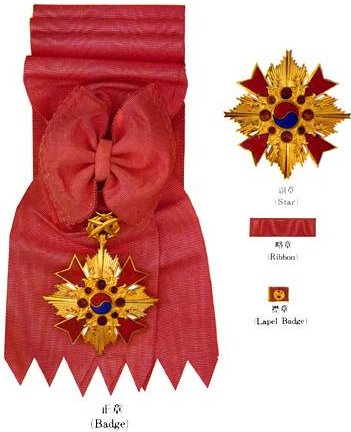
(1st Class, 1st Grade) 광화대장

(1st Class, 2nd Grade) 광화장
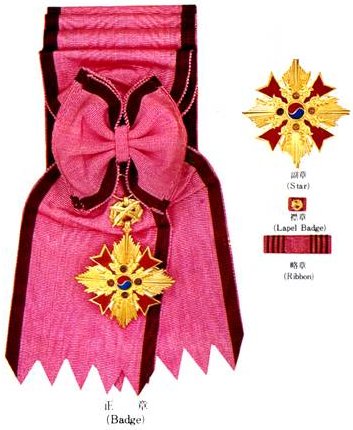
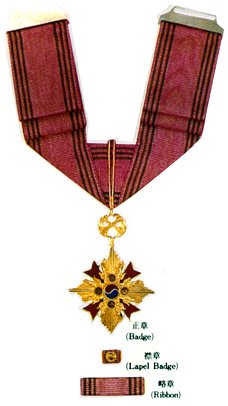

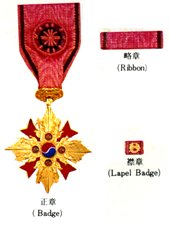
Footnotes:
- Cabinet Decree #68
- Initially part of Presidential Decree #2929, 1967.2.28, but it is still found in the current legislation, under Article 12 (Criteria for Issuance of Ceremonial Medals by Grade)
- Ministry of Foreign Affairs Decree #67, July 31, 1970
- Ministry of Foreign Affairs Decree #102, Mar. 21, 1979.
- Nobusuke Kishi (岸信介1896 – 1987) was a Japanese bureaucrat and politician who was Prime Minister of Japan from 1957 to 1960. He was known for his exploitative rule of the Japanese puppet state of Manchukuo in the 1930s, Kishi was nicknamed the “Monster of the Shōwa era” (昭和の妖怪). Kishi later served in the wartime cabinet of Prime Minister Hideki Tōjō 東條 英機 (1884–1948). He co-signed the declaration of war against the United States on December 7, 1941. After World War II, Kishi was imprisoned for three years as a suspected Class A war criminal. However, he was not charged and eventually released because the U.S. government considered him to be the best man to lead a post-war Japan in a pro-American direction. Even so, he was devoted to revising the Japanese Constitution to get rid of Article 9 (日本国憲法第9条) and remilitarizing Japan.
- Ministry of Government Information, Decorations Overview, (賞勳使覽) Dec.1984, p.256.
- A “RI” (里), also known as a Chinese mile, is a traditional Chinese unit of distance. It has varied considerably over time, but was usually about one third of an English mile. Today, it has a standardized length of a half-kilometer (0.311 miles). This is then divided into 1,500 chi 尺 (Korean 자) or “Chinese feet”.
- I checked the Kwanbo to ensure that the cravat is 36 × 450. I believe this is a typo and that 650 mm is correct. The ribbon and ribbon bar, colors and diameters, have not changed.
- Decorations Law Enforcement Decree 상훈법 시행령, Presidential Decree #26838 대통령령 제26838호, dated 2015.12.31 and implemented on 2016.1.1.[시행 2016.1.1.], partial revision 일부개정.
